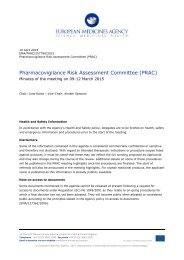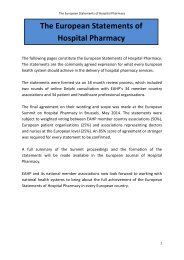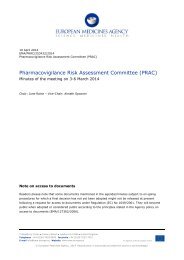WC500169468
WC500169468
WC500169468
Create successful ePaper yourself
Turn your PDF publications into a flip-book with our unique Google optimized e-Paper software.
Administrative details:<br />
EPITT 17956 – New signal<br />
Leading MS: DE<br />
MAH(s): Sanofi- Aventis, Neuraxpharm Arzneimittel GmbH, various<br />
Background<br />
Valproate is a well-known anti-epileptic substance. In most EU Member States nationally authorised<br />
medicines containing valproate (as valproic acid, sodium valproate and, valproate semisodium) are<br />
also authorised for the treatment of patients with bipolar disorder. In some Member States valproatecontaining<br />
medicines are also approved for the prophylactic treatment of migraine.<br />
A signal of mitochondrial toxicity in association with valproate had been received by the German<br />
Agency from a MAH of generic valproate-containing products. The signal included 10 case reports<br />
identified in the literature describing a temporal association between the administration of valproate<br />
and the unmasking of mitochondrial disorders (MID) or aggravation of symptoms in patients suffering<br />
from MIDs. DE confirmed that the signal needed initial analysis and prioritisation by the PRAC.<br />
Discussion<br />
MIDs are predominantly but not exclusively due to dysfunction of the respiratory chain, which is more<br />
frequently inherited than acquired. Epilepsy is a frequent central nervous system (CNS) manifestation<br />
of MIDs.<br />
Comparative studies of the safety of antiepileptic drugs revealed that adverse effects on the<br />
respiratory chain and other mitochondrial functions or structures differ between the most commonly<br />
used drugs. In these studies, valproate was the compound with the greatest potential to interfere with<br />
mitochondrial pathways. This suggested that valproic acid should only be the last option to treat<br />
epilepsy in patients with MID. The PRAC acknowledged that the current product information did not<br />
include warnings/contraindications for use of valproic acid in patients with MIDs and concluded that<br />
further investigation was warranted.<br />
The PRAC appointed Martin Huber (DE) as Rapporteur for the signal.<br />
Summary of recommendation(s)<br />
The MAH for the innovator valproate medicines (Depakine, Epilim) should submit within 90<br />
days to the PRAC Rapporteur a review of mitochondrial toxicity following the administration of<br />
valproate and the MAH should propose wording to be included in the product information as<br />
appropriate.<br />
<br />
A 60-day timetable was recommended for the assessment of this review leading to a further<br />
PRAC recommendation.<br />
4.3. Signals follow-up and prioritisation<br />
4.3.1. Azithromycin (NAP)<br />
<br />
Signal of potentially fatal heart events<br />
Regulatory details:<br />
PRAC Rapporteur: Terhi Lehtinen (FI)<br />
Administrative details:<br />
EPITT 16156 – Follow up October 2013<br />
Pharmacovigilance Risk Assessment Committee (PRAC)<br />
EMA/PRAC/324055/2014 Page 21/73








